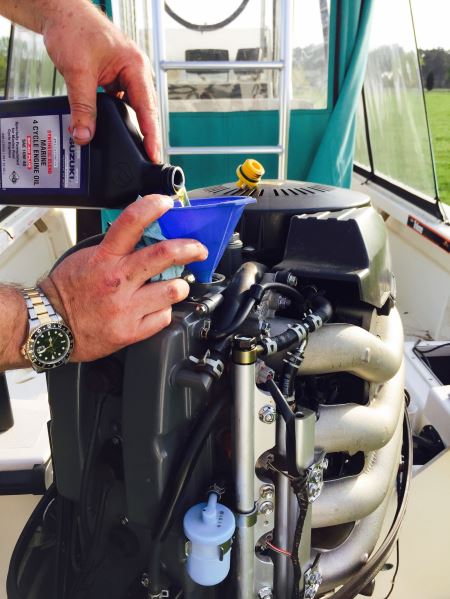.JPG_600.jpg) Getting your rig ready for another season’s use is one of the joys of springtime. Lots of great emotions are awakened; it’s a heady time, as the possibilities for new boating adventures seem endless. Making sure your boat is ready for all the fun is a great responsibility. Even if you’re Johnny-on-the-spot when it comes to winterizing, there’s still a lot to be done to ensure trouble-free outings before that first launch. On the other hand, if your winterizing regimen leaves a lot to be desired, now’s the time to correct all of last fall’s mistakes.
Getting your rig ready for another season’s use is one of the joys of springtime. Lots of great emotions are awakened; it’s a heady time, as the possibilities for new boating adventures seem endless. Making sure your boat is ready for all the fun is a great responsibility. Even if you’re Johnny-on-the-spot when it comes to winterizing, there’s still a lot to be done to ensure trouble-free outings before that first launch. On the other hand, if your winterizing regimen leaves a lot to be desired, now’s the time to correct all of last fall’s mistakes.
System By System
It may be easier to tackle the project if you divvy it up by systems—steering, fuel, engine, drive, cooling, etc. It’ll go faster this way, and there’s less chance to forget something important. There’s also cleaning and polishing to finish off after the systems checkups are complete.
Uncover & Visual Check-Over
For those who have covered the boat up over the winter months, the first step is to check carefully for bees’ nests and other potential dangers (skunks, snakes, cats, etc.) before pulling the cover off. If you’ve waited until it’s late spring, as the temperature warms, there’s more potential for bees and other critters inside. Pulling the cover off will reveal what needs to be done from the outside in. Before the cleanup commences, it’s best to go through the rig and engine looking for problems. Even though your visual inspection may not have revealed critters, take a second look for small bees’ nests—often times, bees will make small, almost undetectable nests in near-impossible locations. These little nests are most often ones that will cause problems for you out on the water; for example, in the overboard tell-tale water indicator on an outboard, in the water intakes, and in the fuel tank vent outlet. If you find any of these “mud dauber” nests, clear them out completely before going boating.
Steering & Controls
Steering and shift/throttle controls are not only critical to driving the boat, but think about this: not checking and maintaining them could make you liable in case of an accident. Therefore, they should be your first priority. For cable systems, ensure they work smoothly, operate properly and are lubricated with marine-grade grease. Hydraulic steering systems should be properly bled to purge air bubbles, and checked to ensure that they work properly. Shift and throttle should be checked with the engine running on a flusher, or in the water tied to the dock; make sure the engine shifts into forward and reverse from neutral and back again. Make sure the propeller stops rotating when the engine is shifted to neutral. If checking on a flusher, it’s much safer to remove the propeller for this check; you will still be able to see the propeller shaft rotating as you shift into and out of gear.
 Fuel System
Fuel System
The engine can’t run if it can’t get fuel. Fuel system checking and maintenance has never been more important thanks to the havoc that alcohol-extended fuels can wreak on fuel lines, filters and components. If the fuel lines are older than three years, they should be replaced with new EPA-compliant hose and new clamps. Look at the fuel hoses carefully; if they’re chalky in appearance and leave residue on your hands when you touch them, it’s a safe bet they need to be replaced. The innards of older fuel hoses are highly susceptible to alcohol deterioration, and if left unchecked can cause clogging, poor running and even engine failure. The fuel filter should be replaced as well. If your rig doesn’t have a water-separating fuel filter, now’s a good time to add one. Check the primer bulb if your rig has one; these are damaged by alcohol-extended fuels too. Finally, check the tank carefully for leaks, cracks and loose mounting.
Batteries & Electrical System
The battery(s) should be charged and checked to ensure it will hold a charge. The terminals and cable ends should be cleaned and checked for tightness. A visual once-over to ensure that it’s secured and can’t tip over is good practice. Lights, bilge pump, horn, gauges and all other accessories should be checked for proper operation and repaired if necessary.
 Engine Operation
Engine Operation
Stern drives must have the block water plugs replaced in their proper locations before running the engine. Belts and hoses should be checked for tightness and cracks. If it wasn’t changed in the fall, the engine oil and filter should be changed now (and don’t forget next fall!). The engine should be connected to a water source (with a flush muff or similar device) and started; it should be allowed to reach operating temperature while running at idle, while checking for proper cooling (the telltale water stream from the engine) and water leaks. All fittings (tilt tube, swivel bracket, hood latches, etc.) should be greased. The gearcase should be checked for damage along with the propeller and propeller shaft. If it wasn’t done in the fall, the gear case lube should be drained, checked for contamination (milky equals water ingestion and seal failure; dark and stinky equals potential gear and bearing damage) and refilled with fresh lubricant. Any corrosion should be sanded down, prepped and repainted. The entire engine should be given a coat of wax to protect it from the water and sun.
Hull Inspection
Check the boat topsides carefully for cracks, loose rubrail or cleats, or a damaged windshield or frame. Next, it has to be done: climb under the trailer and inspect every inch of the hull. You might be surprised at what you find. Aluminum pontoons, decks and hulls must be checked for cracks, impact damage, missing and loose rivets, and broken welds. For fiberglass hulls, nicks, chips and dings (especially those through the gelcoat and into the fiberglass) should be repaired before the season starts. While you’re under there, check the trailer for rust, broken welds, rotted bunks, and deteriorating bunk carpet. Check the trailer lights and wiring and check the tires for weather checking and tread wear. Check the bearings and grease and change if necessary. The winch, tongue jack and coupler/safety chains must be checked as well.
.JPG_600.jpg) Gear
Gear
Lastly, your safety and sports gear should be cleaned, checked and stored. Fire extinguishers, lines (ropes), anchors, fenders, paddles, boat hooks, life vests and cushions, horns/whistles—a few hours minimum should be spent on these necessary “tools of the trade.” Replace any questionable items, clean and dry the rest and store.
Hit The Lake
Don’t forget to renew your boat and trailer registration! A ticket for expired tags is not a fun way to interrupt your first outing.
After a final wash down, you’re ready for the water. A short shakedown cruise is best, to ensure everything’s okay before taking a day cruise or a major trip. All that cleaning, checking and repairing should pay off; if you discover problems, however, now’s the time to correct them—at home, with no pressure. Happy Boating!

